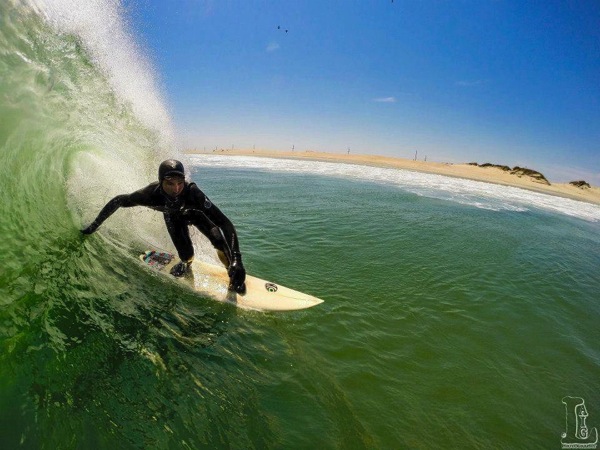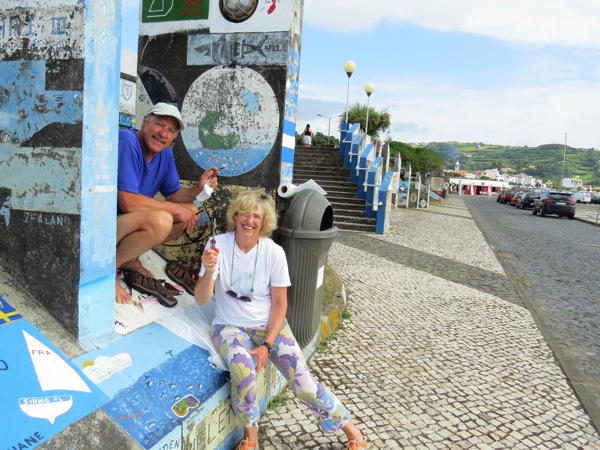Earlier this week our friends on s/v Spirit of Amport, David and Tricia, arrived in Sao Jorge. A few days later the four of us trundled off in a rental car to tour. Our goal: the cheese factory where they give tours Tuesdays and Thursdays.
For once, we knew how to get there having visited the previous day when they were just about to close. Well, almost get there for we did take one wrong turn, but only one, and it was only a five minute diversion.
Now, cows are a huge resource here. Everywhere one turns when out of a town you should see at least one if not multiple of the spotted and solo-color things



We even followed some up the road to a milking station

where we asked if we could take pictures only to have the wife and children waiting in the truck think we were nuts (nothing new there)



So, touring a cheese factory is like visiting an art museum in some other countries–it’s a national treasure and one of which we have definitely partaken. Yes, we have enjoyed and are enjoying the prize-winning food of this island. Which means I should be jogging alongside, not riding in, the car to the cheese factory.
[BLOB BLOG WARNING: GIRLY NEWS! When one consumes five pounds of cheese a day, two things happen: even your stretchy pants get tight and you never have to go again, ever… at least in the foreseeable future. And, if you don’t know what I mean, then you’ve never eaten a bunch of cheese.]

One of the lovely surprises when you start your tour is you get to wear an outfit. Of saran wrap. And like the pic of me running in a bathing suit, it is not a good look.
This was just the beginning when Tricia and I solemnly began our initiation into OMG, do I REALLY have to wear this?!

The guys didn’t seem to mind at all

And, okay, I’m going against my instinct here and voila!

I say against my better judgement for it looks as I’m the one they have to milk.
Of course, our tour guides were handsome in theirs. And, even after I begged and pleaded, they refused to give up their hats in exchange for mine. Wonder why.

Both were students, so these were summer jobs. One spoke excellent English and provided information that explained WHY all the cows.
Basically, there are 90 farmers each with 20 to 30 cows who milk their cows at 4:30a and deliver their milk either to this cooperative or to another gathering place to save them the drive to this factory.
The milk begins its cheese process at 8:00a, where it’s stirred for five hours and a few items added based on their artisan recipe. After the cooking, the cheese is shaped into wheels and cured for two weeks on wooden boards (to absorb the moisture)


From there it goes to another resting place for up to seven months or more

Each lot is labeled and tasted throughout the process to ensure quality control and standardization in order to sell it under the Sao Jorge brand

They sell Sao Jorge in the form of three months aged, four months, and, to us one of the best and strongest, seven months. They also make and sell some under local town names (Beira, Lourais, Topo). (After all that I’ve consumed, I’m sure there will be a Lynnie brand soon.)
 )
)
But, Sao Jorge brand is the one that is most prized and has won numerous competitions for best cheese in Portugal. One huge wheel was being prepared for an upcoming competition, and you can imagine how many cows it took to make this one when the smaller wheels require over 120 liters each…

I did find it interesting that one of our guides said he missed the individuality of each town producing its own cheese; but, economics has led to this joint cooperative among farmers, with this factory producing 500 wheels a day.
We ended our tour with a visit to the store, purchasing yet some more of this island’s delicious cheese. On the way out, we said a goodbye to the cow

and our driver prepped for the next stop

We decided to drive to the north side of the island where there are more fajas (lava flows or rock falls) and check out another natural swimming pool and grab some caffeine.
We ended up in a lovely little village where, oh god, there’s a wall
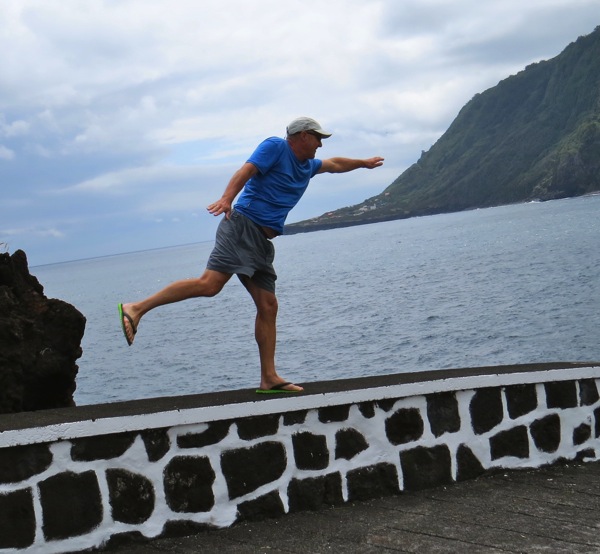
another great looking public restroom,

a natural pool that needed some water, but was still beautiful,

and, some of the rock formations populating a lot of these islands’ shorelines

Enjoying some cafe lattes at the restaurant above the swimming pool, we saw a family digging up potatoes. They already had a huge amount stowed in their shed, so they obviously knew how to grow these spuds.

And, no surprise, we saw the restaurant’s peelings, most likely as a result of fries offered on the menu

David thought it’d be a good idea to buy some fresh ones, so he asked the restaurant owner if the family would sell him some. The owner checked, came back in, and said yes, not a problem. David and then Max went out to purchase some, and the woman started filling up a plastic bag

And, she kept filling, and filling, and filling until the bag literally was just at the bursting point.

With this gargantuan load of spuds, we’d be eating them ’til the cows came home (couldn’t resist).
Not only were these really wonderful to have, they were free. The family would not accept any money. After trying to give them some, David just quietly put some next to a mat so they would have to take it. Then, with David on one side, Max on the other, these beauties were carted to the trunk

Driving up and out of town, which is quite steep and involves a lot of hairpin turns requiring honks to alert descending drivers, we turned off at another miradoura. Peering down at the village, I located the restaurant (on the right-hand side up the hill above the cement boat lift/dock) and almost began drooling as I thought of the numerous, spud-delicious recipes we’d all be trying.

Not to let another opportunity go by for ticking off another Jose, must-see landmark, Max thought we should visit the tuna factory. Located on the opposite side of the island, we piled back into the car and headed for another very memorable tour.
The tuna factory, according to a sheet Jose had given us, was in Faja Grande, just down the road from Calheta, the second-largest town on Sao Jorge. There was also a natural swimming pool he’d indicated as his favorite. No surprise there. This natural pool had a shower and changing room with creative labeling

a bar, a picnic area with BBQ grills, and a pool straight out of a Mediterranean grotto with a long walkway out to the sea

We didn’t have our suits, and it was a bit chilly in spite of the sun, so we just tested it with our toes and enjoyed the view


But, our sought-after destination awaited us: the tuna factory.
Earlier in the week (when looking for the above, natural pool we didn’t find) , Max and I had passed this building that looked suspiciously like some sort of industrial workplace; yet, no signage… anywhere.
So, this time we parked, exited the car and looked again for any hints of yes-you’ve-found-the-infamous-tuna-factory. After searching for some sort of formal door, then asking a passer-by who indicated we were standing in front of the factory, Tricia turned the knob of a decrepit looking, iron door and voila! We were in!
Just so you now I’m not kidding about decrepit, when turning around, this is what you saw as the entrance to this national tuna company

which didn’t inspire too much confidence in what was going into cans.
As the 3:15p whistle blew, we saw blue-jacketed, white-capped women finishing their 15-minute break and heading into this large building on our right. Further down, someone beckoned us into an office area where we met Marlene, a quality control inspector and our subsequent tour guide.

As the tuna aroma began to waft around us, I began to have second thoughts. The second thoughts turned to real alarm when our sweet Marlene began handing out these suspiciously familiar plastic packages. With military precision and countenance she instructed us we must put these on to tour the factory.
With dread I carefully opened the small wad to find, yes, once again, twice in one day, the totally unflattering plastic hat, robe and shoe coverings. For some reason the guys never seemed to mind donning this type of outfit


whereas Tricia and I were a bit more solemn, although Tricia did admit she liked the green better than the clear wrapping as she helped the guys tie up

The best news of the day? Marlene asked us to turn around and pose so she could snap a photo for the company’s FaceBook page. I felt like the poodle that comes out of the groomer wearing some jaunty decoration only to feel utterly humiliated. Oh well, it could be worse. We could have a eau d’tuna cologne we’d have to wear… which, after an hour of tuna touring, we did.
But, I’m ahead of myself. The cologne was slowly added to our bodies once we entered the first step of Santa Catarina Tuna Land.

I must admit Marlene was one of the most enthusiastic tour guides we’ve had. In spite of the eau d’tuna, she gathered her charges (us looking not quite green at the gills) and led the way throughout the flash freezing of skipjack (they use the smallest of the tuna family here)

resulting in, you guessed it, tons of frozen, ungutted, heads-on tuna,

which Marlene told us she sometimes ran her finger down and licked it when she felt hungry. At that point, I started looking longingly at the exit behind us; but, she was so earnest and engaging, I knew I couldn’t desert. So, I faced forward and started mouth breathing.
Next stop, the waste area


where the bits and pieces that were shaved off the frozen bodies were collected for disposal (hopefully, that’s what happened to them).
Marlene then began explaining the different forms the skipjack took, one being big slabs of fillet

some of which are packaged in jars for the Italian market (they only like them in jars)

We followed the packing and sealing of these fillets

as Marlene pointed the lowest grade of tuna (shredded)

versus the middle-grade, a chunky version. All of these were packaged in cans or jars, and we watched in awe as tins were filled,

jar lids and containers tumbled from the sky,


and the tuna received its Santa Catarina branding

During our tour there was a short break to inspect where Marlene did her quality control (she had received a degree in it six years ago and was coming up on her five-year anniversary at Santa Catarina). We were introduced to two young students who were as friendly and warm as Marlene, although a bit shyer

Then, not being able to delay our tour any longer… back into Tuna Land! Whoopee!
Before the sterilization was complete, each jar and can was washed

then placed in a large, holey, metal basket

and, heated the heck out of it

The skipjack was now ready for consumption, and I heaved a sigh of relief.
But, nooooo… there was packaging to be done


Tricia and I both agreed working in packaging where the tuna perfume was less invasive would be the better of the two areas in which to toil.
I snapped a photo for Tricia to send to her Italian friends of just how up close and personal she came to their tuna delicacies

Not quite finished with our ride through Tuna Land, Marlene shepherd us out the door where I stopped mouth breathing, gulped and filled my lungs with air carrying just a tinge of tuna.
Glancing around we saw Santa Catarina had its own pallets

and containers

for shipping their tuna overseas,
all-in-all a pretty impressive operation completed by approximately 140, primarily female, workers filling over 50,000 cans daily (in one shift 8:30a-5p with only 45-minutes of off time).
(Serious hat on) Not only is the production impressive coming out of such a nondescript, unsigned building, but Santa Catarina Canning Industry has and continues to win awards for its sustainability fishing method (2012 Greenpeace), quality (Portugal’s ‘Best of Best’) and contribution to the country’s promotion of Portuguese brands. Check out their pole & line fishing method described on their website [http://www.atumsantacatarina.com/en/inicio/] (Now, all of those poles standing to attention in the stern of those fishing boats make sense…).
And, I must give kudos where due, a company that has Marlene as part of its make-up is, indeed, a fortunate one. Being hosted by this polite, professional, warm, and informative young woman, it’s no wonder Santa Catarina is winning awards.
She’s also a good saleswoman as she led us to the canteen where products were available at a 10% discount

(Goof hat’s back)… but, I still can’t imagine having to earn a living working in a tuna factory. Cheese and clear, plastic wrapping outfits are looking better and better.
And, if it looks like we’re scurrying out with our products at the completion of our tour, now wearing eau d’tuna,

you couldn’t be more right.
Tired but happy with the day’s touring accomplishments, we headed for home with a car filled with cheese, spuds, and tuna.
As Max carefully picked up speed and we settled into our seats, he mentioned it’s just like a cow heading for the barn. All he needed to add was a ‘MOOooooo’…


























































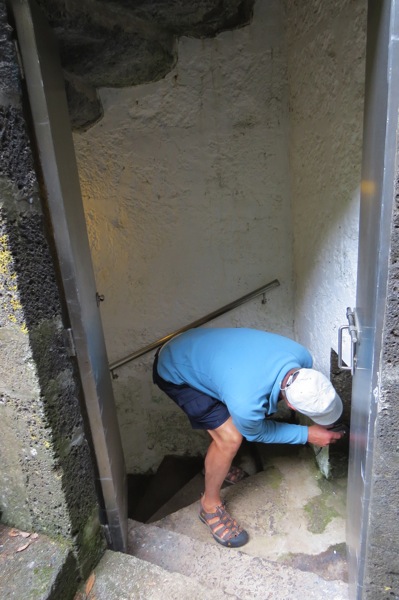















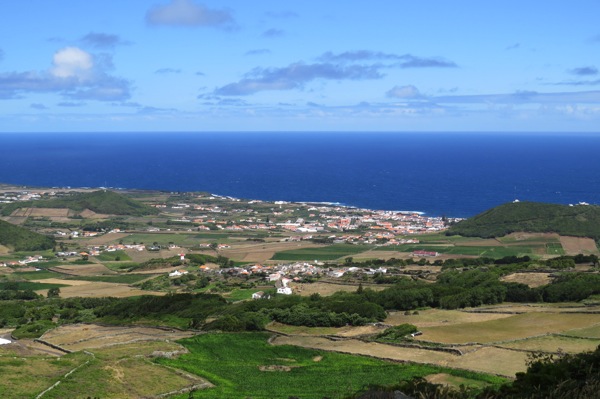







































































 )
)














































